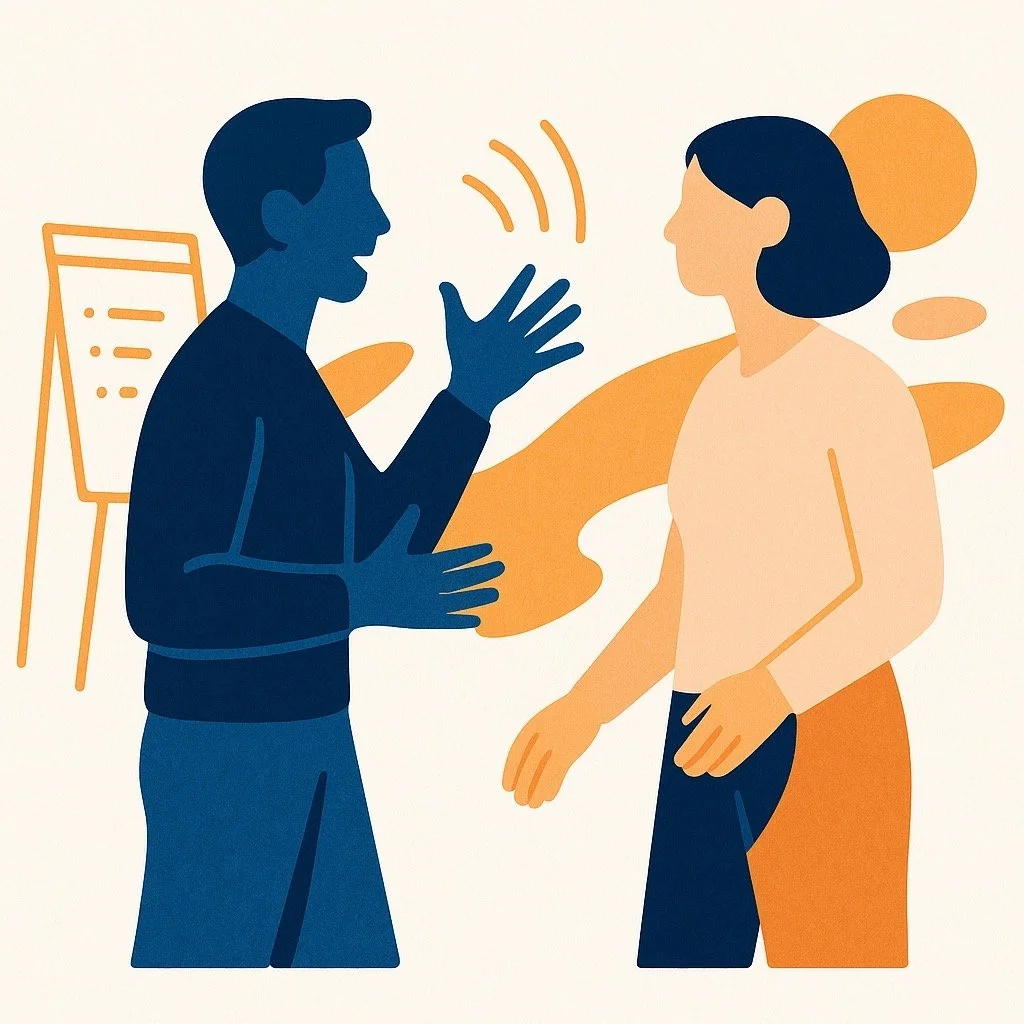Why Every Corporate Workshop Needs a Touch of Improv (Even If You're Not Funny)
When you hear "improv," you probably picture comedy clubs, stand-up comedians, or shows like Whose Line Is It Anyway? The thought of incorporating improv into your corporate workshop might make you break into a cold sweat. "But I'm not funny!" I hear you protest. "My team will hate this!"
Here's the thing: corporate improv isn't about being funny. It's not about performing. And it's definitely not about putting people on the spot to deliver punchlines.
What it is about might surprise you—and transform your next workshop from forgettable to genuinely impactful.
The Big Misconception About Improv in Business
Let's clear this up right away: business improv isn't comedy training. It's a powerful tool for developing critical workplace skills that traditional training methods often miss.
"The goal isn't to turn your accounting team into comedians," says Justin Porter, lead facilitator at Chatterbox Workshops. "It's about using improv principles to build communication muscles, foster genuine collaboration, and develop adaptive thinking."
Corporate improv focuses on the fundamental skills that make improvisation work: active listening, building on others' ideas, staying present, and responding authentically to what's happening in the moment. These same skills happen to be exactly what makes teams effective in today's fast-paced work environment.
Why Improv Works Where Traditional Training Fails
Traditional corporate training often relies on passive learning—sitting through presentations, watching videos, or reading manuals. But research consistently shows that experiential learning sticks better. Here's why improv-based exercises create lasting impact:
1. It Makes Learning Active, Not Passive
Improv demands presence. You can't check your email or mentally drift off during an improv exercise—you have to be there, fully engaged. This level of involvement means concepts don't just enter one ear and exit the other; they become embodied experiences.
"When people physically experience a concept rather than just hearing about it, retention jumps from about 10% to over 70%," notes Porter. "Their bodies remember what their minds might forget."
2. It Creates Safe Spaces for Risk-Taking
Innovation requires risk. But most workplace cultures unconsciously punish mistakes, creating risk-averse employees. Improv deliberately creates consequence-free zones where the only "wrong" move is not participating.
In a well-facilitated improv exercise, failure becomes momentary and even celebrated—because everyone recognizes that willingness to fail is necessary for creativity to flourish. This translates directly to more innovative thinking back at the office.
3. It Builds Real-Time Adaptability
In today's business environment, the ability to pivot quickly is more valuable than perfect execution of outdated plans. Improv is essentially a practice ground for responding creatively to unexpected situations.
"We're training the mental muscles that help people thrive in uncertainty," explains Porter. "When the client changes requirements mid-project or market conditions shift suddenly, you want a team that can respond with 'Yes, and...' rather than 'But we always...'"
Five Improv Principles That Transform Teams (No Comedy Required)
Let's get specific about how improv principles translate to workplace skills:
1. "Yes, And..." — The Foundation of Collaboration
The core principle of improv is accepting what's offered ("yes") and building upon it ("and"). In practice, this looks like acknowledging a colleague's idea before adding your own perspective, rather than immediately shooting it down.
Teams that practice "yes, and" develop a collaborative muscle memory. They become better at building on each other's strengths instead of competing or undermining one another.
2. Active Listening — Beyond Just Hearing
Improv requires listening to understand, not just to respond. In exercises where participants must incorporate specific details from what others have said, people quickly realize how rarely they truly listen in everyday conversation.
"After improv training, meeting quality immediately improves," Porter notes. "People interrupt less, build more coherently on each other's ideas, and walk away with fewer misunderstandings."
3. Status Awareness — Understanding Dynamics
Improv teaches awareness of status dynamics—how we unconsciously establish pecking orders through body language, tone, and word choice. Recognizing these patterns helps teams create more inclusive environments where good ideas can come from anywhere.
This is particularly valuable for teams with formal hierarchies that might stifle communication from junior members.
4. Embracing Failure — From Fear to Freedom
In improv, mistakes aren't just acceptable—they're inevitable and often lead to unexpected creative directions. Exercises specifically designed to make "failure" normal help participants develop resilience and comfort with imperfection.
For perfectionistic workplace cultures, this shift alone can dramatically improve innovation and psychological safety.
5. Being Present — The Antidote to Autopilot
Perhaps the most transformative aspect of improv is how it pulls people out of their habitual responses and into the present moment. In a world of constant distraction, the ability to be fully present with colleagues or clients is increasingly rare and valuable.
"We see people wake up during these exercises," says Porter. "Suddenly they're actually seeing their colleagues, maybe for the first time in years of working together."
How to Incorporate Improv Without the Cringe Factor
If you're sold on the benefits but worried about implementation, here are practical ways to incorporate improv principles without making anyone uncomfortable:
Start Small and Build Gradually
Begin with simple exercises that feel more like icebreakers than "improv." For example, have pairs practice active listening by having one person speak for 30 seconds about their weekend while the other listens without interrupting, then accurately summarizes what they heard.
Frame It Properly
Never call it "improv comedy." Instead, introduce exercises as "collaborative thinking activities" or "communication skill-builders." Explain the business purpose behind each exercise so participants understand the relevance.
Create Psychological Safety
Establish ground rules that make it clear nobody will be put on the spot or expected to perform. The facilitator should always participate first to demonstrate vulnerability, and exercises should start with pairs before moving to small groups.
Connect to Real Work Challenges
The most effective improv exercises directly address specific workplace challenges. If your team struggles with meetings that go nowhere, focus on exercises that practice building on others' ideas. If interdepartmental communication is the issue, use exercises that highlight different perspectives.
Real Results: Beyond the Workshop Walls
At Chatterbox Workshops, we've seen remarkable transformations when teams incorporate improv principles into their regular work:
A technology team that reduced meeting time by 30% while increasing solution quality by implementing "yes, and" techniques
A healthcare organization that improved patient satisfaction scores after staff practiced presence and status awareness
A financial services firm that reported significantly higher employee engagement after incorporating quick improv exercises into their weekly team huddles
The common thread? None of these successes required anyone to be funny. They simply required people to be human, present, and willing to practice new ways of interacting.
Getting Started: Low-Risk Entry Points
Ready to dip your toe in the improv waters? Here are three simple exercises you can try in your next team meeting:
1. One-Word Story
Have the team stand in a circle and create a story one word at a time, with each person contributing a single word in sequence. This builds listening skills and demonstrates how we create meaning collectively.
2. "Yes, And" Brainstorming
When discussing a challenge, establish a rule that responses to ideas must begin with "Yes, and..." rather than "But" or "However." Track how this changes the energy and output of your discussion.
3. Active Listening Pairs
Have pairs take turns speaking for one minute about a work challenge while the listener cannot interrupt. The listener then must accurately summarize what they heard before responding. This simple exercise often reveals how rarely we truly listen.
The Bottom Line: It's About Skills, Not Comedy
The most important thing to remember is that incorporating improv into your workshops isn't about making people perform or putting them on the spot. It's about creating experiences that build crucial workplace skills in a way that lecture-based training simply cannot.
"The skills that make great improvisers—listening, adapting, collaborating, staying present—are exactly the same skills that make great teams," Porter emphasizes. "And you don't have to be remotely funny to develop any of them."
As the workplace continues to evolve at breakneck speed, the teams that thrive will be those that can respond creatively to change, collaborate effectively across differences, and remain fully present with each other and their customers. Improv principles offer a direct path to developing these capabilities.
So the next time you're planning a workshop, consider adding a touch of improv—no comedy required. Your team might just surprise themselves with what they're capable of when they stop performing and start being present.
Ready to bring these principles to life in your organization? Discover how Chatterbox Workshops can help your team develop the communication and collaboration skills needed for today's workplace challenges.




